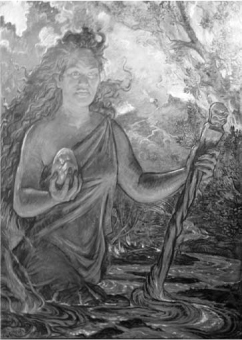Oceanic Mythologies: Australian Aborigine and PolynesianPolynesian Pantheons |
What is the myth of Pele? |
Pele was a descendant of Sky and Earth. She was rivalled in power only by her older sisters, the goddesses of the sea and of the snow-capped mountains, who worked to curb her natural volcanic fury. Her favorite sister was Hi’iaka’, who had been born of an egg kept warm by Pele, under her arm, until the hatching. Pele and Hi’iaka’ lived out of the reach of their two threatening sisters in the fiery crater of Kilauea, high above the sea on the Big Island. One day in a dream Pele heard the sound of drum beats and dancing and was so attracted to the sound that she sent her spirit to follow it—all the way to Kauai. There she witnessed wonderful dancing and music and, disguising herself as a beautiful young woman, she joined in. Soon after, she was noticed by a handsome chief named Lohiau, and the two became lovers. But the time came when Pele’s spirit needed to return to her sleeping and dreaming body on the Big Island, or else the fires of her volcano would have died out. So her spirit left Lohiau. But now the lovers longed for each other, so Pele sent her brother Lono to Hi’iaka’ to ask her to bring Lohiau to her. Hi’iaka’ managed to overcome monsters and other trials and to make her way to Kauai. There she found that Lohiau had died, but she succeeded in reviving him. Some say that Pele became impatient, assuming that Lohiau and Hi’iaka were having an affair, so she attacked them with her fire. In one version of the story, Hi’iaka and Lohiau did, in fact, end up as lovers, even in the face of Pele’s rage.

The Polynesian god Pele is associated with the volcano Kilauea on the Big Island of Hawaii.
